White noise offers a sharp, uniform hiss that covers all frequencies equally, making it powerful for masking sounds but potentially harsh over time. Pink noise emphasizes lower frequencies, creating a softer, more natural sound that’s easier on your ears for relaxation or sleep. Your preference depends on your sensitivity and goals—if you want calm, pink noise might suit you better, but exploring both can access more effective ways to improve your home comfort and wellness.
Key Takeaways
- White noise offers a flat frequency spectrum with a sharp, hissy sound, while pink noise emphasizes lower frequencies for a softer, more natural tone.
- Pink noise is generally easier on the ears for prolonged use and may promote deeper relaxation and sleep.
- Both sounds influence neural activity, aiding in focus, reducing distractions, and enhancing sleep quality, but individual responses vary.
- Use these sounds mindfully in moderation to prevent auditory fatigue, irritation, or dependence.
- Choosing between white and pink noise depends on personal preference, purpose, and sensitivity, often requiring experimentation for optimal comfort.
Understanding the Basics: What Are White Noise and Pink Noise?
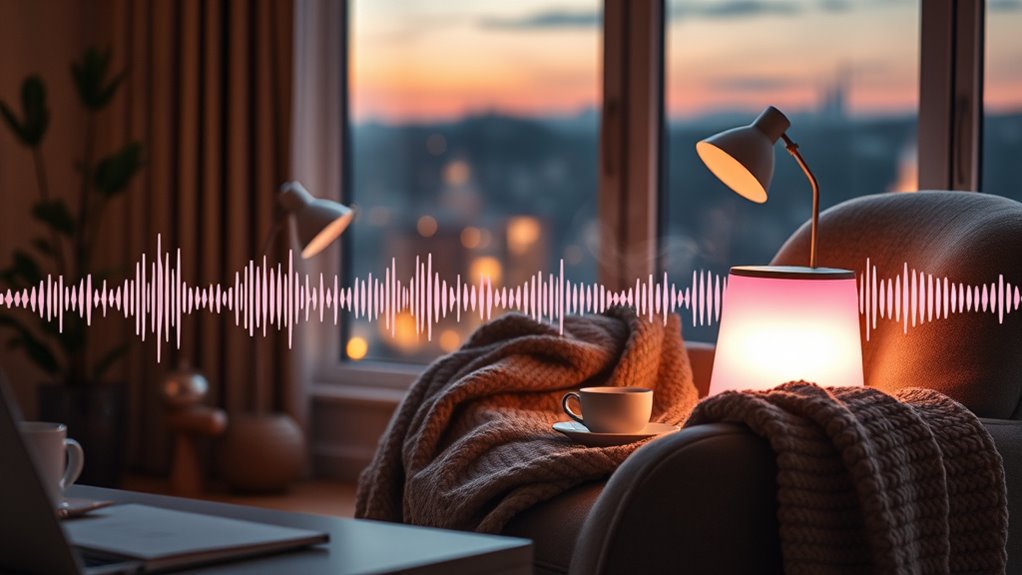
White noise and pink noise are both types of sound signals used for relaxation, sleep, and sound masking, but they differ in their frequency composition. In sound therapy, white noise creates a consistent, high-frequency sound that can help drown out distracting noises. It’s often used for auditory masking, which prevents sudden sounds from disturbing your rest or concentration. Pink noise, on the other hand, offers a more balanced sound, with equal energy across octaves, making it softer and more soothing for prolonged use. Both types serve to create a calming environment, helping you focus or sleep better by reducing external disruptions. Understanding these basics enables you to choose the right sound for your needs, optimizing your wellness and comfort in everyday settings.
How Do They Differ in Sound Composition and Frequency Distribution

White noise has a flat sound spectrum, meaning all frequencies are equally loud, covering the entire audible range. Pink noise, however, decreases in intensity as frequencies increase, resulting in a balanced distribution that sounds more natural. Understanding these differences helps you choose the right type of noise for your needs.
Sound Spectrum Distribution
Understanding how sound spectrum distribution differs between white noise and pink noise requires examining their unique frequency compositions. White noise contains equal energy across all audio frequencies, resulting in a flat spectrum that sounds consistent to your sound perception. This means each frequency contributes equally, creating a sharp, hissing sound. In contrast, pink noise’s energy decreases by about 3 dB per octave, emphasizing lower frequencies. This distribution produces a more balanced, mellow sound that’s easier on your ears and better suited for masking background sounds. The difference in sound spectrum distribution impacts how you perceive the audio, with white noise feeling brighter and more intense, while pink noise offers a smoother, more natural sound. Both serve different purposes based on how you experience sound perception.
Frequency Range Differences
While both white noise and pink noise cover a broad range of frequencies, they differ markedly in their sound composition and how these frequencies are distributed. White noise contains a uniform sound spectrum, meaning all frequencies are equally represented, resulting in a consistent sound that can be sharp or hissy. In contrast, pink noise features a frequency spectrum where lower frequencies are more prominent, with energy decreasing as the frequency increases. This creates a more balanced sound distribution, making pink noise sound smoother and more natural to the human ear. These differences in frequency range and sound distribution impact how each noise type interacts with your environment, influencing their effectiveness for sleep, relaxation, or masking unwanted sounds.
The Science Behind Their Effects on Sleep and Focus
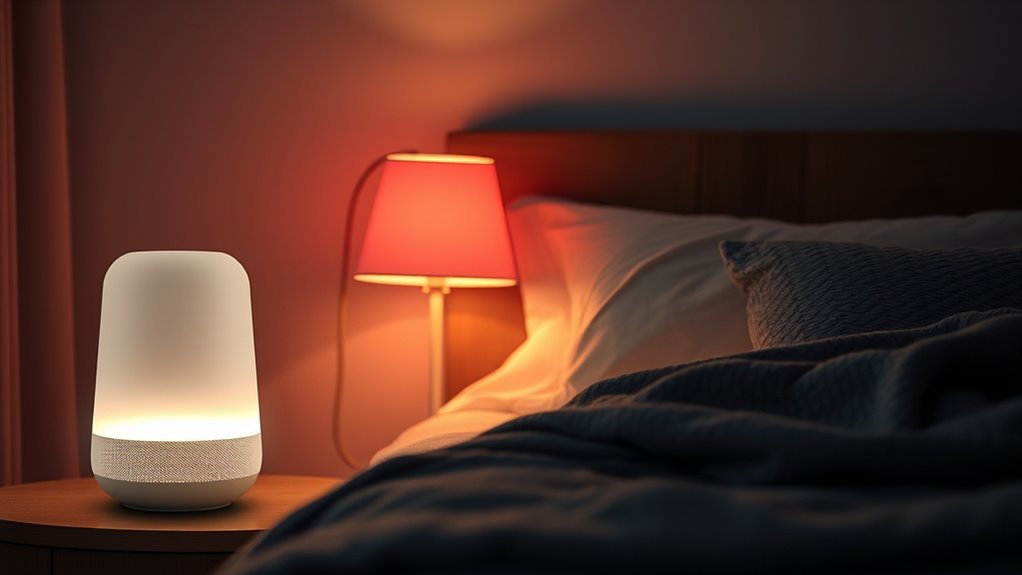
Both white noise and pink noise influence sleep and focus by affecting your brain’s ability to filter out distractions and regulate neural activity. They promote neural synchronization in your auditory cortex, which helps your brain process sound more efficiently. This synchronization reduces the brain’s effort to distinguish relevant sounds from background noise. Here’s what it means for you:
- Enhanced neural pathways improve your ability to concentrate and stay alert.
- Better regulation of neural activity promotes deeper, more restful sleep.
- Consistent auditory stimulation helps your brain establish a stable rhythm, minimizing disruptions.
Common Myths and Misconceptions About White and Pink Noise
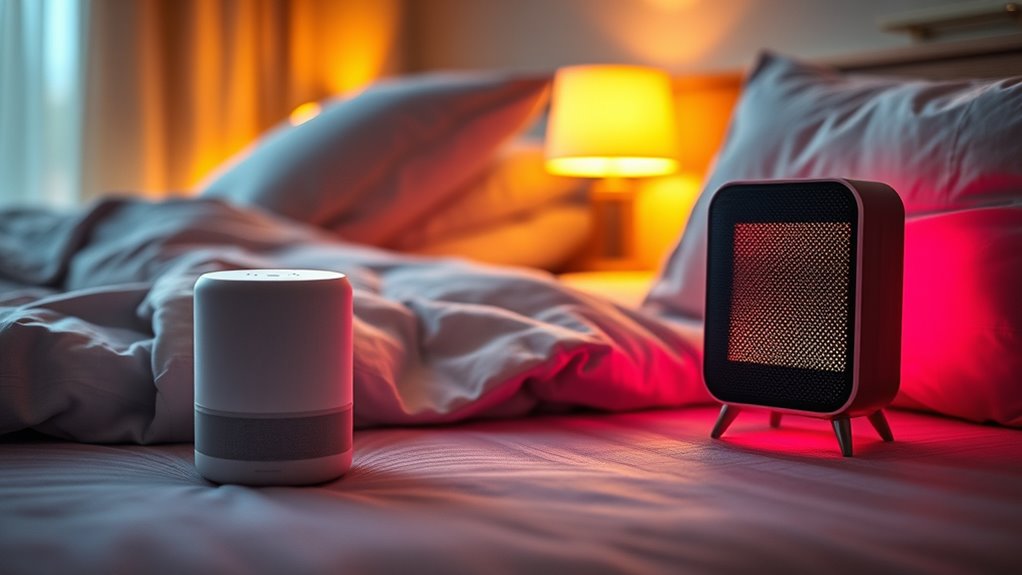
Many people believe that white noise and pink noise are just generic sounds that always have the same effect, but this isn’t true. Myth busting reveals that sound misconceptions often lead to oversimplified ideas about their benefits. For example, some think white noise is always better for sleep, while pink noise is only for relaxation. In reality, their effects vary depending on individual preferences and specific situations. Not everyone responds the same way to these sounds, and their effectiveness depends on factors like sound quality and volume. It’s important to understand that both white and pink noise are tools, not magic solutions. Recognizing these misconceptions helps you make informed choices tailored to your personal needs, rather than relying on stereotypes or assumptions.
Which Noise Type Is Better for Relaxation and Stress Reduction?
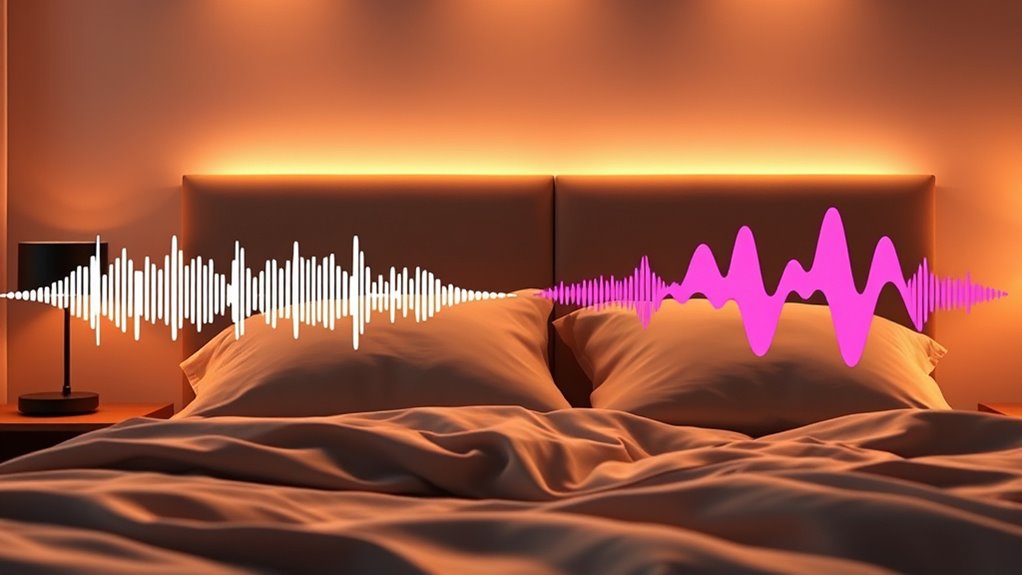
You might wonder which noise type helps you relax more effectively. White noise and pink noise can differ in how well they reduce stress and promote calm. Let’s explore which one could be better suited for your relaxation needs.
Relaxation Potential Differences
When it comes to relaxation and stress reduction, pink noise often proves more effective than white noise because its balanced, soothing sound pattern can help slow brainwave activity and promote a calm state. In sound therapy, pink noise’s equal energy distribution makes it better for creating a relaxing environment. During noise comparison, many find pink noise less harsh, reducing overstimulation. Consider these points:
- Pink noise’s consistent, smooth sound supports deeper relaxation.
- Its natural, ambient quality mimics environmental sounds, aiding the mind in unwinding.
- Pink noise encourages sustained calm, making it ideal for long-term stress relief.
Choosing pink noise might enhance your relaxation potential, making it a preferred option for calming your mind and body through sound therapy.
Stress Reduction Effectiveness
Pink noise generally proves more effective than white noise for relaxation and stress reduction because its balanced, soothing sound helps slow brainwave activity and promotes a calm state. This makes pink noise ideal for sound masking and noise therapy, as it seamlessly blends into your environment, reducing distracting sounds and creating a tranquil atmosphere. Its gentle, consistent tone encourages your body to relax, lowering cortisol levels and easing tension. Unlike white noise, which can be harsh or jarring, pink noise’s deeper, softer sound supports sustained stress relief. If you’re seeking a calming background for meditation, sleep, or relaxation, pink noise’s effectiveness in stress reduction makes it the better choice, helping you unwind and restore mental clarity.
Practical Tips for Incorporating These Sounds Into Your Home Environment
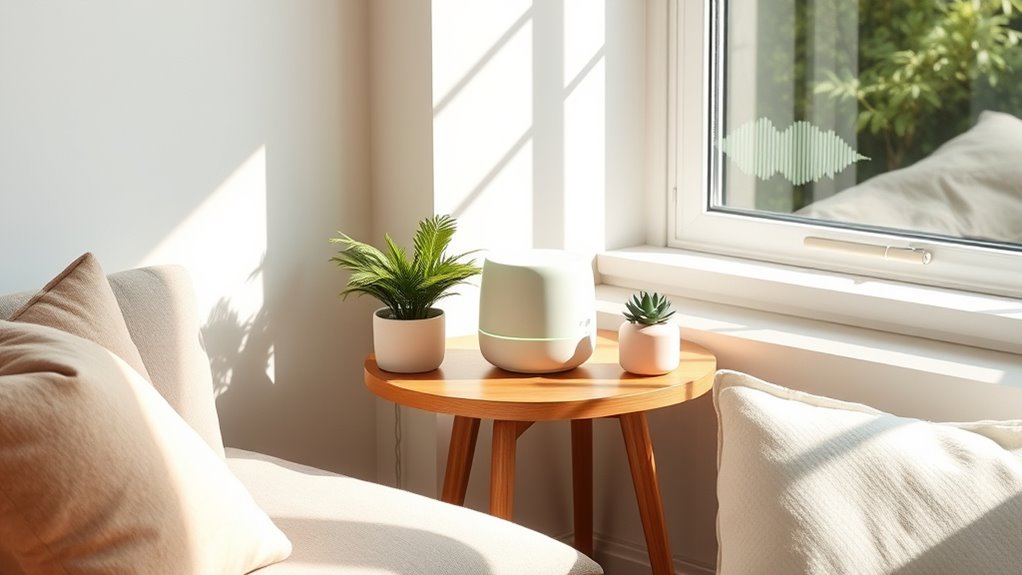
Integrating white or pink noise into your home environment can be simple and effective with a few strategic steps. First, choose the right sound source, like a dedicated white noise machine, a smartphone app, or a speaker playing ambient music or nature sounds. Second, set the volume at a comfortable level that masks distractions without overwhelming you. Third, establish consistent times—such as during work, relaxation, or sleep—to reinforce the habit. Using ambient music or nature sounds alongside white or pink noise can enhance the calming effect and create a soothing atmosphere. Remember, consistency is key. By following these steps, you’ll seamlessly incorporate these sounds into your daily routine, promoting better focus, relaxation, and overall wellness.
Potential Benefits and Drawbacks of Using White and Pink Noise Regularly
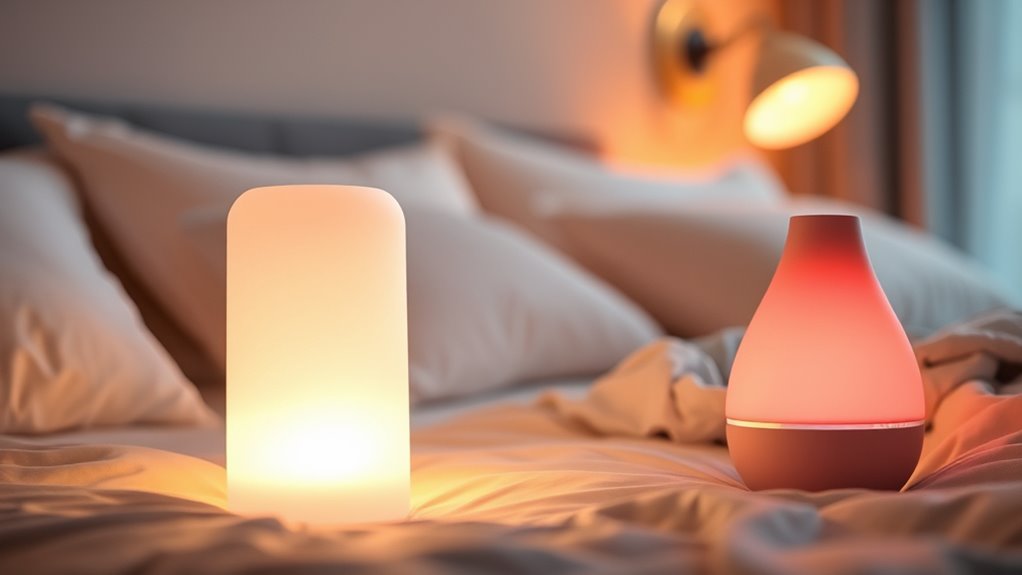
Using white and pink noise regularly can offer significant benefits, such as improving focus, enhancing sleep quality, and reducing stress. Noise therapy with these sounds can create a calming environment and serve as effective sound masking, blocking disruptive noises. However, there are drawbacks to contemplate. Excessive exposure might lead to auditory fatigue or dependence on constant sound to relax or sleep. Some people may find the high-frequency components of white noise irritating or disruptive over time. Pink noise, while gentler, may not be as effective for certain individuals or situations. It’s important to use these sounds mindfully and in moderation. Balancing the benefits of noise therapy with potential drawbacks ensures you don’t inadvertently hinder your comfort or sleep quality.
Choosing the Right Sound Based on Your Personal Needs and Preferences
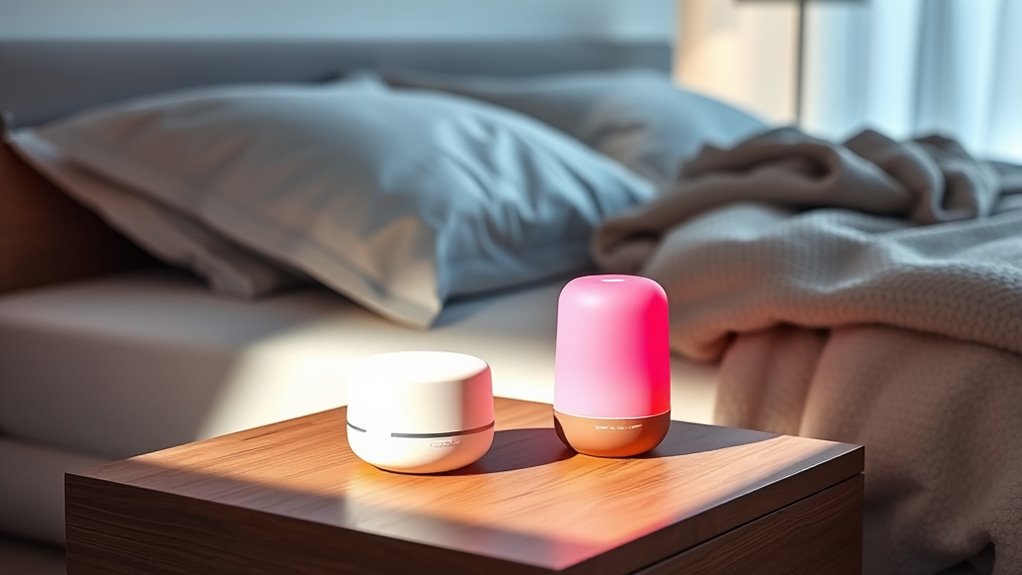
Choosing the right sound depends on your specific needs and how you respond to different noise types. Your auditory perception varies, influencing whether white noise or pink noise works best for you. To choose effectively, consider these factors:
- Purpose of sound therapy – if you seek deep relaxation or focus, pink noise’s balanced frequencies may be better.
- Sensitivity to noise – if you’re easily disturbed by high frequencies, white noise might be more suitable.
- Personal preference – trust your comfort level; some find white noise too harsh, while others prefer its consistency.
Understanding how your auditory perception interacts with each sound helps you tailor your environment for better sleep, concentration, or relaxation. Experimenting with both types can reveal which sound aligns best with your wellness goals.
Frequently Asked Questions
Can White or Pink Noise Help With Tinnitus Relief?
White or pink noise can help with tinnitus relief by providing effective tinnitus masking, which reduces the perception of ringing or buzzing sounds. Using sound therapy, you create a calming background that distracts your brain from tinnitus. Pink noise, in particular, is often preferred for its soothing qualities, making it easier for you to relax and sleep better while managing your tinnitus symptoms.
Are There Health Risks Associated With Prolonged Exposure to These Noises?
Imagine someone listening to white noise for hours daily, thinking it’s harmless. Long-term exposure to these sounds can pose risks, including potential hearing damage. While white and pink noise are generally safe at moderate levels, prolonged exposure at high volumes may harm your ears over time. To protect your hearing, keep volume levels reasonable and limit exposure duration, especially during sleep or extended use.
How Do Different Environments Affect the Effectiveness of White and Pink Noise?
Your environment considerably influences how white and pink noise work for you. In quiet, cluttered spaces, ambient soundscapes can enhance focus and relaxation. Acoustic environments with background noise may diminish their effectiveness or cause distraction. For peak benefits, adjust the noise type and volume to suit your surroundings, ensuring the sound blends seamlessly without overpowering or being drowned out by ambient sounds.
Can Children or Pets Be Negatively Impacted by These Sounds?
Children and pets can be negatively impacted by white or pink noise if they have sound sensitivity or experience sleep disturbances. You might notice your pet becomes anxious or restless, or your child has trouble sleeping if the noise is too loud or persistent. To prevent this, keep the volume at a comfortable level and monitor their reactions, adjusting as needed to guarantee the sounds promote relaxation without causing stress.
Are There Specific Devices or Apps Recommended for Optimal Sound Quality?
Think of your device as a trusted lighthouse guiding your sleep. For ideal sound quality, you should choose reputable brands like Bose, Marpac, or Hatch, which offer high-quality sound generators. Apps like Relax Melodies or White Noise Plus also deliver excellent sound quality, customizable options, and user-friendly interfaces. These tools help you create a calming environment, ensuring your white or pink noise experience is as clear and soothing as a gentle ocean breeze.
Conclusion
Now that you know the differences between white and pink noise, you can make an informed choice to enhance your home comfort and wellness. Whether you’re seeking better sleep or sharper focus, selecting the right sound is a step in the right direction. Remember, it’s all about finding what works best for you—because when it comes to noise, one size definitely doesn’t fit all. Trust your ears and tune in to your personal needs.








